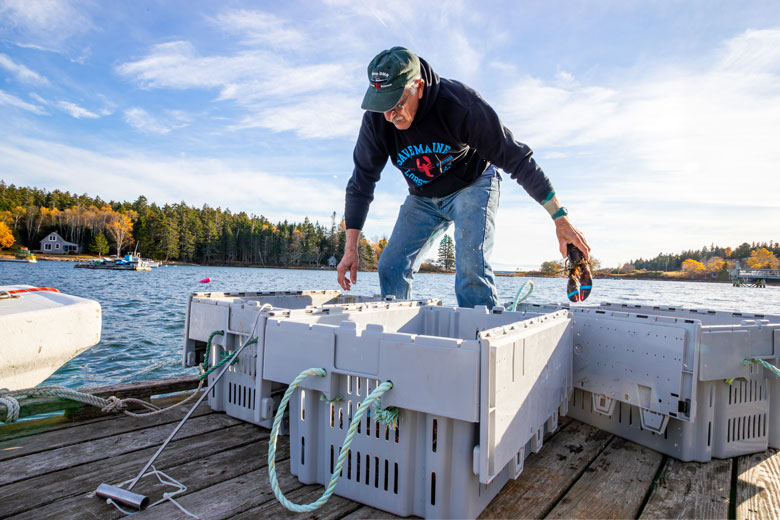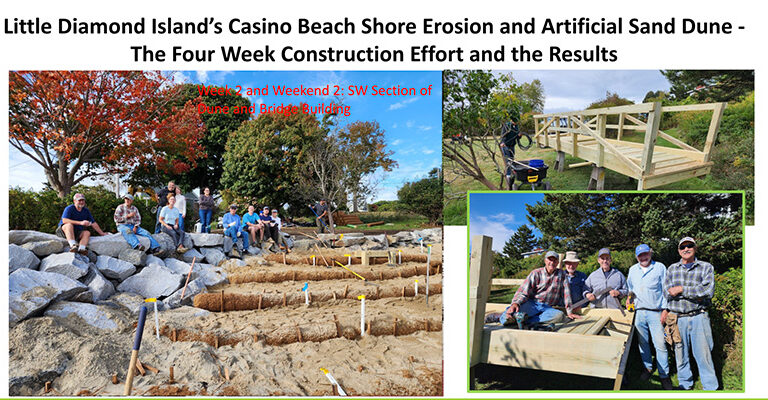Longtime fisherman Danny Staples has his own wharf on Pleasant Point Gut in Cushing, where he and several others can access the water, land lobster, and do some maintenance of their vessels.
But that piece of waterfront didn’t help Staples this past fall, when his boat’s rudder broke as he was several miles out to sea hauling traps, near Old Horse Ledge. He first got towed back to Cushing, where he beached the boat to assess its damage. Fixing it there wasn’t possible, so he had to get it towed another nine miles up the St. George River to Thomaston so it could be removed from the water for a repair.
The ordeal highlighted a difficult aspect of fishing in Cushing: while the Knox County town has plentiful deep harbors where fishermen can bring their catch ashore, it has no public boat launches. If it did, Staples could have gotten his broken-down vessel out of the water much closer to home.
“I needed to be hauled out ASAP. It would have been awful nice, and awful secure, to be able to do it right here.”
“I needed to be hauled out ASAP,” he said. “It would have been awful nice, and awful secure, to be able to do it right here, and know that it’s on land. Then I could assess what was wrong, and how to go about fixing it.”
Soon, that could change: Cushing is in the early stages of an ambitious plan to buy two waterfront parcels that would eventually become a public launch for commercial and recreational boaters.
If the project goes ahead, it would provide a reliable new option for reaching the water in the town, where roughly 70 local fishermen together catch more than 2 million pounds of seafood each year. It would also give community members a local spot for putting in their watercraft and help the town better handle emergencies on nearby islands.
While Cushing is not unique among Midcoast fishing towns in lacking a public boat ramp, its efforts to create one can offer lessons for many other communities along Maine’s coast that have struggled to protect their working waterfronts from worsening storms, competition from land developers, and other challenges that have accelerated in recent years.
Two decades ago, Island Institute put out a landmark report that found just 20 miles of Maine’s 5,500 miles of shore were still being used for fishing, aquaculture, or other marine businesses.
It was around the time of that report that Cushing made its own decision that, years later, could allow it to take the unusual step of reinforcing Maine’s working waterfronts.
At the time, Staples was serving as the local harbormaster, and he found it unusual that a peninsular town with miles of shore didn’t have its own public landing. He also was paying boat excise taxes and proposed that the town save up a portion of that combined revenue for the purpose of improving public access to the water.
Local officials sent the idea to voters, who approved it, and since then the town has annually transferred between $10,000 and $15,000 into the water access account, which now has about $340,000.
Even with that money, it hasn’t been easy for the town to go ahead with its original vision for improving access to the water. In 2017, the community did accept a gift of 15 acres along the water which is now Good Neighbors Park, but that area is too shallow for anything but clamming, kayaking, or similar uses.
Five or six years ago, Staples—who has also been on the select board and other local committees—learned that a family might be willing to sell a waterfront property in South Cushing that had once been used by a local lobsterman, but that opportunity vanished as the property was sold on the private market.
Fearing a similar outcome, officials are now pouncing on the chance to obtain a separate property that also once belonged to a fisherman, but who has passed away and whose family is now negotiating a sale to the town.
The select board has approved a preliminary agreement to buy the property, which takes up two adjacent parcels on Barnacle Lane and includes an aging pier that sticks out into Pleasant Point Gut—just a stone’s throw from Staples’ own wharf—as well as an old home and some sheds.
The town would buy the site for an estimated $730,000, with half coming from its savings and the rest from the Land for Maine’s Future Program. The board of that state program tentatively approved the funding at its September meeting, but the town must meet several conditions to receive it, including getting a new survey and appraisal and holding a local vote that’s likely to take place in early 2026, according to current Harbormaster Austin Donaghy.
Eventually, officials hope to remove the pier and home and rebuild the site with a boat ramp and floating dock. That work would require additional funding and at least two or three more years of work.
In addition to providing access to fishermen, Donaghy noted that the project would also help local property owners put recreational vessels into the water. And it would give the town somewhere to store its own boat and better coordinate the response to medical emergencies or fires. Staples noted that one blaze burned for several days on Gay Island, which is just across the harbor from his wharf and includes several homes.
If the town can complete the project, it’ll represent a small but significant victory for Maine’s working waterfronts, which are critical access points for the fishing and aquaculture businesses that land hundreds of millions of dollars’ worth of seafood each year.
Those properties have been threatened by worsening storms, like the ones that battered Maine’s coast two winters ago. It has also been hard for private wharf owners to hold onto their property given the growing demand for housing on Maine’s coast.
Several things came together to help Cushing with its own project. It took foresight for the town to start saving up money years ago, as well as the additional pledge of money from the Land for Maine’s Future Program, which provides grants for water access and working waterfront protection.
Olivia Richards, a community development officer at Island Institute’s Center for Marine Economy, helped the town seek the LMF funding.
“Working waterfronts are critical for Maine because if these access points didn’t exist, people couldn’t get onto the water,” Richards said. “It’s as simple as that. We need wharves. We need these access points in order for the marine economy to flourish and thrive.”
Both Staples and Donaghy also praised the owners of the property on Barnacle Lane for entertaining the town’s offer, when they could likely get more for the prime shorefront land on the private market.
“There’s very little working waterfront left,” Staples said. “If you pass up opportunities like this, they don’t come around weekly, monthly, or yearly.”





